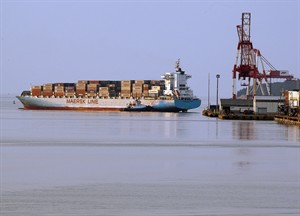
Dalhousie University research project takes aim at invasive species
HALIFAX – Dalhousie University is working on a system to test the cleanliness of ballast water, the only such facility in Canada, just as new regulations could be introduced that would govern what ships could discharge at ports around the world.
The Aquatron laboratory is scheduled to conduct its first tests of ballast water at the Halifax school later this month.
“We have to imitate a ship taking on ballast and then we hold the water so that represents transit of the ship going somewhere,” said John Batt, the manager of the research facility. “Then we test the water on a de-ballast.”
Batt said water will be pumped through a control system and a ballast water management system separately. The results will then be compared and the tests will be repeated with different salt water levels.
“This is a huge need the industry has,” Batt said. “A huge portion of Eastern Canada’s revenue and GDP comes from the fishing industry and that’s potentially at threat.”
Frost and Sullivan, a global business research and consulting firm, released an analysis in 2010 estimating that the ballast water cleaning industry would generate total revenues of $34.1 billion until 2020.
A spokesman for the federal Fisheries Department said it’s hard to quantify the exact economic impact of invasive aquatic species.
But a paper released in March from the University of Notre Dame, the University of Wyoming and the Technical University of Delft in the Netherlands estimates that average damages due to invasive aquatic species for U.S. ecosystems in the Great Lakes alone total about $138 million annually.
Dalhousie University’s research comes as the United Nations works on efforts to combat the threat of invasive species that enter foreign waters through ballast water.
Once ratified, the UN Convention for the Control and Management of Ships’ Ballast Water and Sediments would require ships to have ballast water management systems that limit the number of species that are discharged into foreign waters.
It would also require all ships built on or after 2009 to have a ballast water management system and all ships to be retrofitted for one in 2014 or 2016, depending on the ship’s size.
But the convention has yet to gain the support of some of the world’s largest shipping countries and isn’t legally binding yet.
In June, the U.S. Coast Guard implemented strict regulations limiting the number of species that ships are allowed to discharge into U.S. waters through ballast.
Ships are not allowed to discharge more than 10 large organisms — which are defined as those greater than 50 micrometres — for every cubic metre. No more than 10 small organisms — which are between 10 and 50 micrometres — can be discharged.
They also implemented stricter penalties and if any ships attempt to enter the U.S. without a tested ballast water management system they face fines of up to $10,000 or one to 10 years in prison.
The UN International Marine Organization says ballast water is responsible for transferring an estimated 7,000 to 10,000 different species globally everyday.
In Atlantic Canada, sea squirts — tunicates foreign to the region’s water — have had a costly effect on the mussel industry. The Aquaculture Association of Nova Scotia says the animals have hampered half of the province’s $2.5 million mussel industry.
The region’s fishing sector has also struggled with European green crabs in recent years.
Join the Conversation!
Want to share your thoughts, add context, or connect with others in your community? Create a free account to comment on stories, ask questions, and join meaningful discussions on our new site.














Leave a Reply
You must be logged in to post a comment.